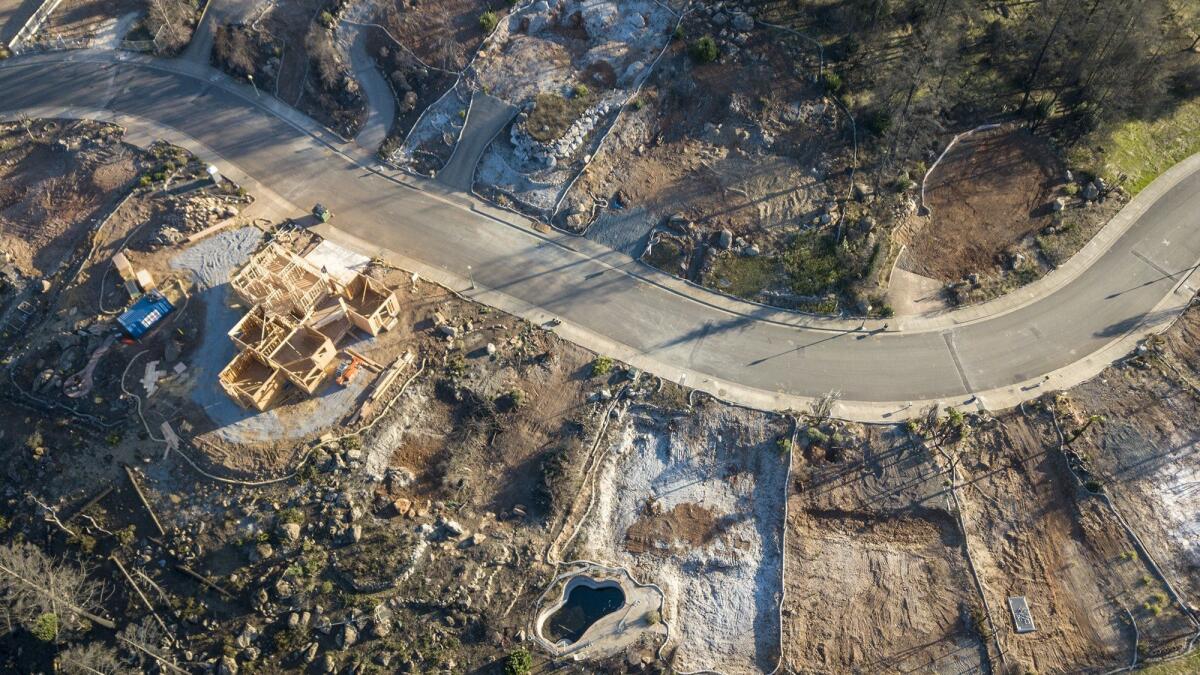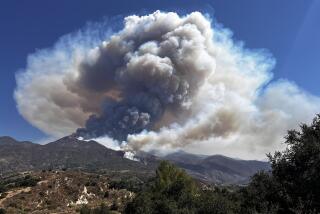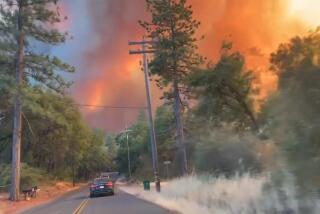How do you build a safer city after California’s worst wildfire? Santa Rosa officials say the answer may have to wait

After the Tubbs fire destroyed his home, Will Abrams’ son read a book about the Great Chicago Fire of 1871. He learned that after the catastrophic blaze, the city required all new buildings to be constructed with fireproof materials like brick and stone.
“Is our new house going to be made out of brick, Dad?” 10-year-old Leo asked his father.
If this notion — to rebuild with careful intent after a fire — is obvious to a child, it should be to wine country officials, Abrams recalls thinking.
If only it were that simple, officials say.
One year after 5,500 Sonoma County homes were lost in California’s most destructive wildfire in recorded history, civil servants are balancing the threat of future disaster with an immediate and dire need for housing. So far, they have prioritized dwellings, clearing the way for residents to rebuild quickly.
Little — if anything — has been done to strengthen building codes or zoning ordinances, which could lead to burdensome expenses for both cash-strapped residents and local government.
“In California, we make that calculation every time we build,” said Santa Rosa Mayor Chris Coursey. “We don’t stop people from building because we live in an area with natural risks.”
In fact, officials have made rebuilding as simple as possible in a county that was facing a serious housing shortage even before the fire. In Santa Rosa — which bore the brunt of the fire’s wrath — most construction permits are now approved within a few days.
As of early October, more than 1,200 of the 2,700 homes lost in Santa Rosa were being rebuilt, most of them on the same properties that were engulfed in flames just a year before.
There are no plans to impose zoning ordinances that might restrict building in the county’s most fire-prone areas, said David Guhin, Santa Rosa’s assistant city manager. That could change when the city reviews its general plan in the coming months, Guhin said. But that is unlikely.
Santa Rosa drafted its first general plan shortly after the 1964 Hanly fire, which carved a path of destruction nearly identical to the Tubbs fire. It urged developers to consider earthquakes and floods as they built, but not wildfires. The current plan doesn’t either.
“We can’t tell someone where to rebuild their house,” Guhin said. “We can only make sure they’re built in a much more resilient way.”
Many of them will be, thanks to California’s most recent building codes, which are some of the toughest in the country. Any home built since 2008 in the wildland-urban interface — where structures mingle with flammable vegetation — must follow strict fire-retardant standards, including mesh coverings on attic vents and double-paned windows. Sprinkler systems are now required in all new homes.
“We’ve held everyone to those current standards,” said Sonoma County Supervisor James Gore. “But we also haven’t added any.”
The county has instead focused on strengthening its emergency alert system. During the Tubbs fire, alerts reached only a fraction of those in the path of the blaze.
The county has also launched a curbside chipper program, intended to help residents create defensible space — the 100-foot buffer between a structure and vegetation — around their homes. A county-sponsored marketing campaign encourages property owners to clear flammable plants from their land and harden their houses.
But fire safety experts say that mere encouragement isn’t enough. The county should consider enforcing strengthened building and landscaping regulations, especially in neighborhoods that aren’t flagged as fire hazard zones but could ultimately succumb to an unpredictable weather event like the Tubbs firestorm, said Max Moritz, a wildfire specialist at UC Santa Barbara.
Take, for example, Coffey Park, which lost more than 1,300 homes in the blaze, but is not in the wildland-urban interface.
“As a researcher, I see lots of strong evidence supporting the idea that we should have more science-based regulatory constraints on how we build,” Moritz said. “Yet we shy away from that.”
When Sonoma County officials argue against stricter building regulations, some note that many of the homes built to the county’s strictest codes were still destroyed in the Tubbs fire.
The other argument? Money. Tougher codes would tack on tens-of-thousands of dollars to already expensive projects in middle-income neighborhoods like Coffey Park. And enforcing those standards requires resources the county just doesn’t have, Gore said.
This funding shortfall is a problem most local governments confront after disasters, said Michele Steinberg, wildfire division director for the National Fire Prevention Assn.
“You can put whatever you want in a code or a standard,” Steinberg said. “If you can’t enforce it, it’s worthless.”
Some residents are pushing officials to explore less expensive ways to make the area more resilient. Abrams, who lost his home and is now the block captain for a fire-recovery neighborhood group, may be the most vocal among them. The 47-year-old has proposed a financial incentive program for those who meet certain fire-safe landscaping and building requirements.
Gore, the supervisor, said that such a program may be in the works. The county has applied for a $6.5-million FEMA grant that would help residents fire-harden their homes, similar to earthquake retrofitting incentive programs.
Abrams has also suggested county officials provide financial incentives to large private landholders like ranchers, vintners and golf courses owners who build fire breaks around their properties, and to develop tools that track progress toward enhanced community safety.
Abrams, a tech entrepreneur, left New York for Sonoma County a few years ago because he craved the balance of quaint urbanity and nature that the area offers.
Even so, Abrams and his wife, Eki, considered moving after the fire. But they chose to stick around; they wanted to show their 10-year-old son and 7-year-old daughter how to advocate for a more resilient community.
“Our kids are not going to have a choice — they’ll have to join together to fight these climate change issues,” Abrams said. “I want them to see it in action, and learn from it, and be better prepared to deal with it.”
laura.newberry@latimes.com | Twitter: @LauraMNewberry
More to Read
Sign up for Essential California
The most important California stories and recommendations in your inbox every morning.
You may occasionally receive promotional content from the Los Angeles Times.











